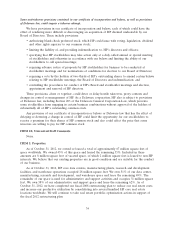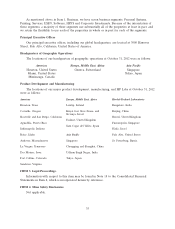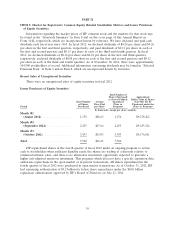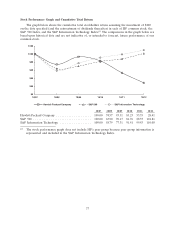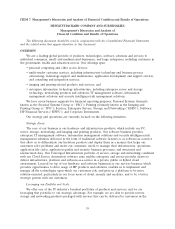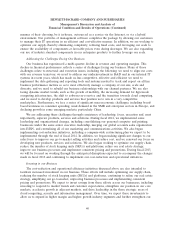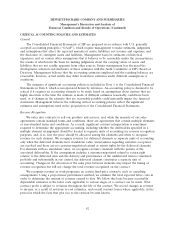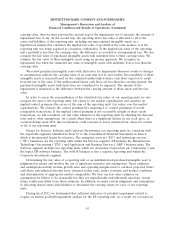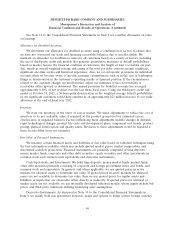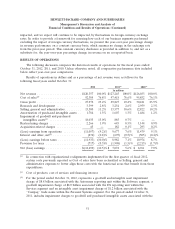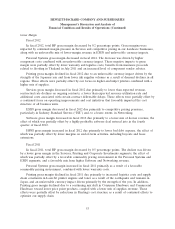HP 2012 Annual Report Download - page 52
Download and view the complete annual report
Please find page 52 of the 2012 HP annual report below. You can navigate through the pages in the report by either clicking on the pages listed below, or by using the keyword search tool below to find specific information within the annual report.HEWLETT-PACKARD COMPANY AND SUBSIDIARIES
Management’s Discussion and Analysis of
Financial Condition and Results of Operations (Continued)
Business Combinations
We allocate the fair value of purchase consideration to the tangible assets acquired, liabilities
assumed and intangible assets acquired, including in-process research and development (‘‘IPR&D’’),
based on their estimated fair values. The excess of the fair value of purchase consideration over the fair
values of these identifiable assets and liabilities is recorded as goodwill. When determining the fair
values of assets acquired and liabilities assumed, management makes significant estimates and
assumptions, especially with respect to intangible assets.
Critical estimates in valuing certain intangible assets include but are not limited to future expected
cash flows from customer contracts, customer lists, distribution agreements, and acquired developed
technologies and patents; expected costs to develop IPR&D into commercially viable products and
estimating cash flows from projects when completed; brand awareness and market position, as well as
assumptions about the period of time the brand will continue to be used in our product portfolio; and
discount rates. Management’s estimates of fair value are based upon assumptions believed to be
reasonable, but which are inherently uncertain and unpredictable and, as a result, actual results may
differ from estimates.
Other estimates associated with the accounting for acquisitions may change as additional
information becomes available regarding the assets acquired and liabilities assumed, as more fully
discussed in Note 6 to the Consolidated Financial Statements in Item 8, which is incorporated herein
by reference.
Valuation of Goodwill and Purchased Intangible Assets
We review goodwill and purchased intangible assets with indefinite lives for impairment annually
and whenever events or changes in circumstances indicate the carrying value of an asset may not be
recoverable. The provisions of the accounting standard for goodwill and other intangibles allows us to
first assess qualitative factors to determine whether it is necessary to perform the two-step quantitative
goodwill impairment test. For our annual goodwill impairment test in the fourth quarter of fiscal 2012,
we performed a quantitative test for all of our reporting units. Due to the recent trading values of our
stock price, we believed it was appropriate to have recent fair values for each of our reporting units in
order to assess the reasonableness of the sum of these fair values as compared to our market
capitalization. In the first step, we compare the fair value of each reporting unit to its carrying value.
We determine the fair value of our reporting units using a weighting of fair values derived most
significantly from the income approach and to a lesser extent the market approach. Under the income
approach, we calculate the fair value of a reporting unit based on the present value of estimated future
cash flows. Cash flow projections are based on management’s estimates of revenue growth rates and
operating margins, taking into consideration industry and market conditions. The discount rate used is
based on the weighted-average cost of capital adjusted for the relevant risk associated with business-
specific characteristics and the uncertainty related to the business’s ability to execute on the projected
cash flows. Under the market approach, we estimate the fair value based on market multiples of
revenue and earnings derived from comparable publicly-traded companies with similar operating and
investment characteristics as the reporting unit. The weighting of the fair value derived from the
market approach ranges from 0% to 50% depending on the level of comparability of these publicly-
traded companies to the reporting unit. When market comparables are not meaningful or not available,
we may estimate the fair value of a reporting unit using only the income approach. If the fair value of
the reporting unit exceeds the carrying value of the net assets assigned to that unit, goodwill is not
impaired and no further testing is required. If the fair value of the reporting unit is less than the
44


